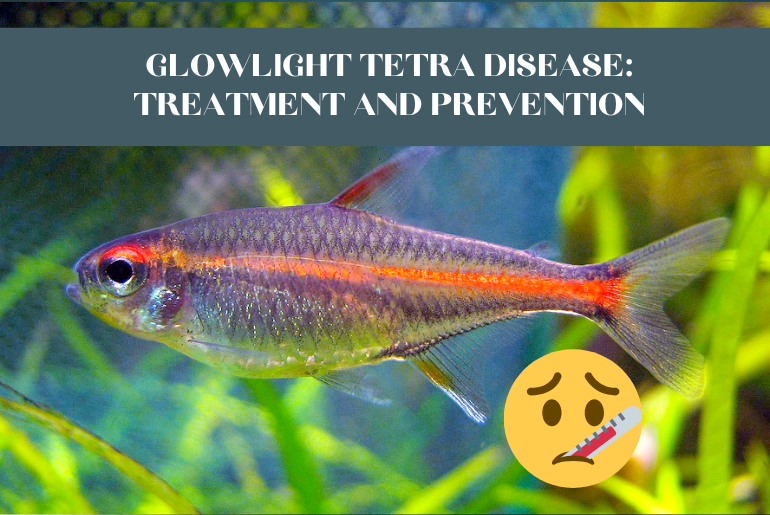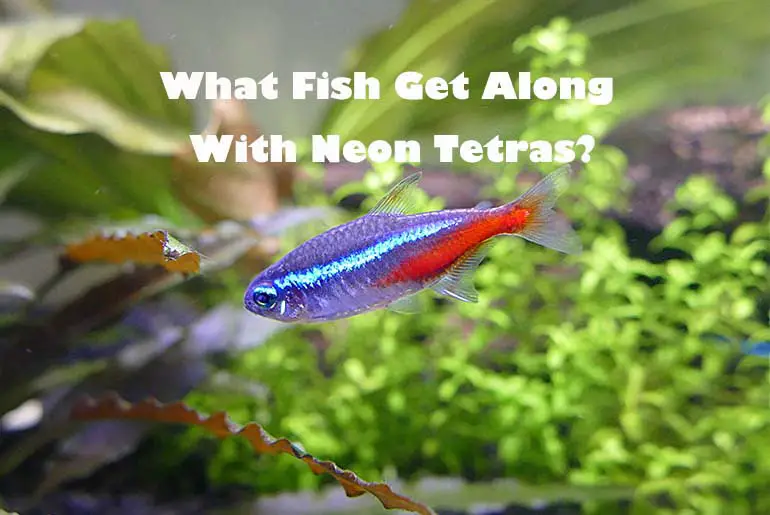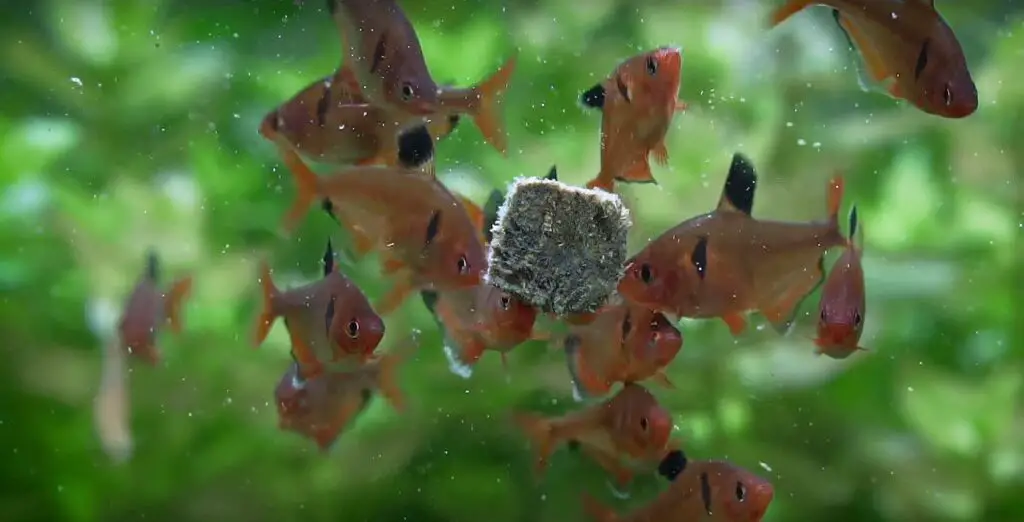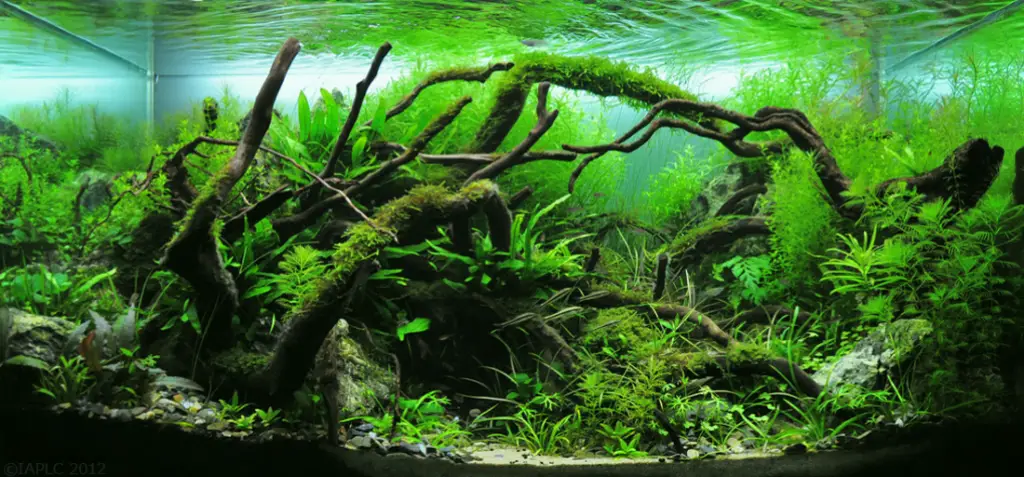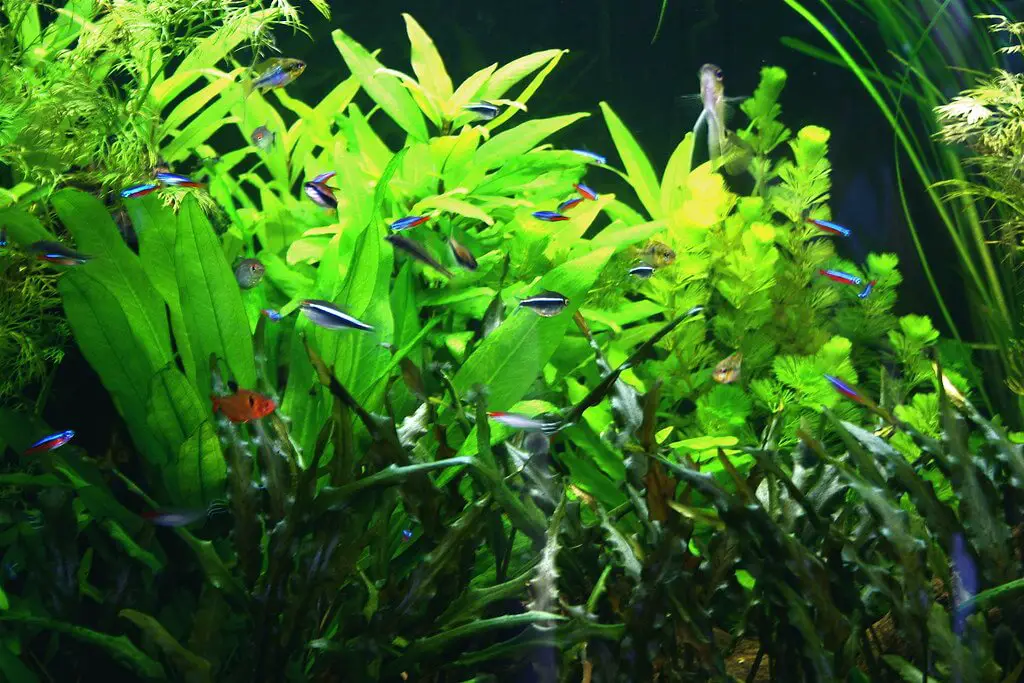Glowlight Tetras are ideal for beginner fishkeepers as these beautiful fish are hardy. But being hardy doesn’t mean Glowlight Tetra is immune to diseases. I will describe Glowlight Tetra’s disease, treatment, and prevention in this article. Let’s get into this!
The most common diseases that Glowlight Tetras suffer from are Neon Tetra disease, Fish or tail rot, Ick/Ich or white spot disease, dropsy, fungus, Ichthyobodo infection, Hemorrhagic septicemia, gill flukes, Popeye and Lymphocystis.
The disease can be prevented by maintaining water parameters and the nitrogen cycle and maintaining a stress-free environment by not overcrowding the aquarium. Glowlight Tetras also can get diseases if they are kept with aggressive alpha fish.
I compiled a list of 10 Glowlight Tetra diseases. You will learn to recognize, treat, and prevent them in your pet Glowlight Tetras. You can read the following article to cure your sick pet and prevent such disease to again erupt in the future.
Do Fish Get Diseases?
To answer, yes. Just like every living being can get a disease, your pet Glowlight can get a disease too.
The disease is caused by various reasons like eating dead fish or bacteria transmitted through contaminated water.
If you get your fish from the fish store, it might harbor the infection from the tank water it came from. This infects your home aquarium.
Though it is rare, fish can also transmit the infection to humans. So, to protect both you and your pet fish, you have to adopt some precautions.
10 Glowlight Tetra Diseases: Symptoms, Diagnosis, and Treatment
Although Glowlight Tetras are hardy fish, with inadequate care and an unstable ecosystem inside the water, they can develop diseases.
Before reading this, you should be confident if your pet Glowlight Tetra suffers from the following diseases and treat them accordingly. However, if you give the wrong treatment without being certain of a particular disease, your pet fish might get even sicker.
It is important to note that not all diseases can be cured. However, some diseases are curable, and there’s hope.
Read below to read the guide to some common Glowlight Tetra diseases and infections that can affect fish and ways to treat them.
Ichthyobodo Infection
It’s essential to keep your Glowlight Tetra healthy and thriving in their aquarium, but unfortunately, there are times when they can fall ill. One common disease that afflicts Glowlight Tetras is Ichthyobodo, caused by a protozoan parasite that targets their weakened immune systems.
This can occur when the fish are stressed by living in a dirty tank with overcrowded populations, leading to weakened immunity. Overfeeding can also contribute to the problem by reducing the immune system’s effectiveness.
Once the immune system is weakened, it becomes easier for the parasite to attack the fish, causing an infection that can harm their health. As a responsible fish owner, keeping your aquarium clean and well-maintained is crucial, ensuring that your Glowlight Tetras have a healthy and stress-free environment to thrive in.
Symptoms
- The parasite affects the gills and skin of your fish. You should check if your fish’s skin is steel-grey and if it contains blue mucus.
- Lethargy and stop eating
- Your fish might swim on the top gasping for air
Treatment
Ichthyobodo can spread rapidly and harm other fish in the aquarium, so it’s best to quarantine any infected fish outside the main pond. Swift treatment is essential to avoid extensive fish mortality.
A fast-acting treatment for single-celled parasites is effective, along with high-quality feed and filtered pond water with activated carbon to prevent Ichthyobodo.
Neon Tetra Disease
Neon Tetra disease is a highly contagious and incurable disease caused by a Microsporidian parasite called Pleistophora Hyphessobryconis.
When your fish consumes a dead fish or is fed with tubifex (which may contain the parasite), your fish begins to deteriorate in health and ultimately dies.
The parasite will eat your fish from the inside out, starting from its gut. Although it is called Neon Tetra disease, your pet Glowlight Tetra may also suffer from this disease.
Symptoms
- Cysts on the body
- Secluding behavior, although Glowlight Tetras are a schooling fish
- Fish becomes pale and loses color
- In extreme cases, the spine may become a curve
- Fish finds it difficult to swim. Your fish becomes restless
- In secondary cases, the fish might show signs of fish rot and bloat
Treatment
Sadly, your Glowlight Tetra will not survive if it gets this disease. The best option would be to seclude them in a quarantine tank and euthanize them to prevent further contamination.
Gill Disease Or Gill Flukes (Dactylogyrosis)
Gill Flukes or gill disease is a common Glowlight Tetra disease and is found in tropical fish as well. Your fish might look like they have rapid fin movement but aren’t swimming.
The parasite Gill (Dactylogyrus spp) or Skin Flukes (Gyrodactylus spp) will drill into your fish skin and cause a secondary infection.
Your fish will have difficulty breathing if the parasite infests their gills. This parasite can infest your fish if your fish lives in a stressful environment with poor water quality.
Symptoms
- Accumulation of mucus on the body and gills
- Gills look like some organisms, and rapid movement of gills and fins has chewed them.
- Gills are red because of bacterial infection
- Red skin (However, in late-stage, their skin becomes pale)
Treatment
- You should treat your pet fish with anti-worm medication like Praziquantel which prevents flukes and worms from harming your fish.
- It is good if you can also treat them with antibacterial medications.
- For the tank, you should treat your water with a dechlorinator.
Medication
Fin Rot Or Tail Rot
As the name suggests, Fin rot disease affects the Glowlight Tetras’ fins and tail. It is often caused by bacteria like Flavobacterium columnare, Aeromonas, and Pseudomonas.
However, the aquarium’s condition also contributes to the condition as a poor and dirty tank stresses your Glowlight Tetras.
Furthermore, if your Glowlight Tetras have aggressive tank mates, the aggressive fish might bite Glowlight’s fin, which makes it susceptible to this disease.
Symptoms
- The edge of the fins/tail becomes white or red-blood streaked, and the whiteness gradually reaches the fin/tail base.
- Rotting of tail/fins
- Your fish might seem like it has lost its fin, shows an exposed fin
- Difficulty in swimming because of the loss of fins and tail
Treatment
You can treat your fish in three ways
- The environment of your fish tank should be clean, and the Tetra should be in groups. However, keeping them in overcrowded aquariums will make them stressed. This stress causes low immunity and, thus, fish rot.
- You should keep nitrogen levels in balance. If you keep them with aggressive fish, the aggressive ones will nip at your fish which might aggravate this condition.
- If you catch fin rot in your pet late, treat your pet with an antibiotic. You can buy a commercially available antibiotic that is effective for gram-negative organisms.
Medicine
API Melafix Fish Remedy for Bacterial Infection in Freshwater Aquarium
API PIMAFIX Antifungal Freshwater and Saltwater Fish Remedy
Lymphocystis
Lymphocystis is a common Glowlight Tetra disease and is a viral infection in tropical and saltwater fish.
This virus is of the genus Lymphocystivirus and belongs to the family of Iridoviridae. This disease is contagious, and most fish die from secondary infection, so it is necessary to look after your fish.
The virus may be present in live food or dirty aquariums where fish have died. Stress is also a contributor to this disease.
Symptoms
- Your fish has a gross lesion that appears white and granular on its skin and fins and occasionally on its mouth also. It looks like cauliflowers.
- When the lesion grows in number, the fish finds it difficult to swim
Treatment
Sadly, there is no good treatment for this disease. However, you can do the following to prevent the secondary infection from killing your pet:
- You should keep your Glowlight Tetra in a stress-free environment
- Give your pet a weekly bacterial treatment
If you maintain a good ecosystem for your Glowfish Tetra to survive, the disease will resolve itself.
Medicine to Cure Fungus
API Melafix Fish Remedy for Bacterial Infection in Freshwater Aquarium
Ick/Ich (Ichthyophthrius), aka White Spot Disease
Ick/Ich or White spot disease is caused by protozoa called Ichthyophthirius multifiliis. It is one of the most common Glowlight Tetra diseases and is a contagious disease in aquarium fish, but you don’t need to worry as it is curable.
It is characterized by white spots on the skin resembling a sprinkle of salt. The parasite creates cysts on your fish skin, and once the cysts reach full development, the cyst falls on the substrate and creates more parasites.
Symptoms
- Small white dots appear on the fish’s body.
- Your fish tries to rub itself against a hard surface, substrate, or décor in the aquarium.
- They have a poor appetite and look uncomfortable
Treatment
- The parasites have infested the water, so you must first clean the tank
- Slowly increase the temperature of your tank over 24 hours to 29 degrees Celsius to speed up the parasite’s life cycle.
- You should keep the tank at this temperature while the treatment continues
- You should add a white spot-treatment medication that contains malachite green and formalin in the tank. Only the dose written in the package should be kept.
- Remove carbon from your filter, as it might absorb the medication you add to the water.
- However, you should remember that the cold-water fish that can’t survive in such hot temperatures should be treated with aquarium salt and medication. Otherwise, it will add more stress to the Glowlight Tetras.
- If you buy additional Glowlight Tetras, you can keep them in quarantine tanks.
Medicine for Ich
API SUPER ICK CURE Fish remedy
Red Pest (Hemorrhagic Septicemia)
Hemorrhagic septicemia, also called red pest, is one of the most common diseases that a tropical fish like Glowlight Tetra might have.
It is caused due to high ammonia levels and other organisms. Distinct red streaks might appear on your fish.
In red pests, the bacteria enter your fish’s circulatory system and damage blood vessels, tissues, and the heart. This results in bleeding and causes dropsy.
Symptoms
- Bright red streaks on the fin
- Your fish has a patchy red discoloration on the flanks of its body
- Bulging eyes
- Bloating
- Open sores
- Hyperventilation and gasping at the surface
- Swimming strangely
Treatment
Sadly, since this disease is internal, external treatments are barely effective. However, you can do the following.
- Clean the whole tank with a disinfectant. Use Acriflavin or Monacrin. You should use it for a 0.2% solution at the rate of 1 ml per liter. It is colored. However, the color will disappear.
- You can add an antibiotic to your fish food, like tetracycline and chloromycetin. Add 250 mg of antibiotic to 25 gm fish flake.
Medicine
API PIMAFIX Antifungal Freshwater and Saltwater Fish Remedy
Dropsy (Edema)
Dropsy is a very common fatal symptom in fish. It is caused by the accumulation of fluid inside the body’s cavities and tissues.
Although it isn’t a disease, it is a symptom of a disease. Viral, bacterial, and parasitic infections can cause dropsy. It is not curable once the disease spreads to the kidneys.
Thus, you might save your Glowlight Tetras if you discover the condition as early as possible. However, most of the time, your fish might have reached its final stage, and no possible cure is available.
Symptoms
- Swollen abdomen with raised scales
- Your fish loses its appetite
Treatment
- You should remove your pet fish from the tank if it shows this symptom.
- You should clean the tank and visit a specialist to check if your fish has a viral, bacterial, or parasite infection or if any underlying morbidity is there.
- Mostly, the condition will have worsened before you diagnose this symptom. So it is better to seclude it in a quarantine tank to prevent further contamination and treat it with medications. If your fish doesn’t respond, you should euthanize it.
Medicine for Dropsy
API FIN & BODY CURE Freshwater Fish Powder Medication
Fungus
Fungal infections are fairly common for tropical fish like Glowlight Tetra. More commonly, Fungi that belong to the genus Saprolegnia affect the fish.
The fungi grow on your fish’s body and live off of dead tissue. For instance, if an aggressive fish bites your Glowlight Tetra, the fungi will have an easy time preying on your fish.
So, it is important to keep your fish with other tranquil fish. It is commonly a secondary infection.
Symptoms
- Whitish cotton or wool-like growth appears on your fish’s body, mouth, or gills.
- Discoloration of fins and the tail is also another sign
- Since it is a secondary infection, the symptoms of another disease are present
Treatment
- You should first treat the underlying condition, then treat the secondary infection of fungus in a quarantine tank.
- You should clean the original tank and change 40-50% of the water.
- Water treatment like Methylene blue, Acriflavine should be used.
- Aquarium salt should be added into the quarantine tank about one tablespoon per gallon.
- You should treat your pet fish with an antifungal medication.
- You can also increase the temperature of water to increase effectiveness.
- Lastly, remove half of the tank water every 2-3 days and use dechlorinated water at the correct temperature. Make sure that you use aquarium salt every time you change the water.
Medicine
API PIMAFIX Antifungal Freshwater and Saltwater Fish Remedy
Popeye (Exopthalmia)
Popeye is a common Glowlight Tetra disease. It is the symptom in which the eye of your Glowlight Tetra seems to be swollen and stuck out of its eye socket.
It can occur in a single as well as in both eyes. This condition is also called exophthalmia. This is caused when excess fluid builds up behind the eye forcing the eyeball to stick out.
Sometimes, your fish may also become blind. Bad water conditions, infection, Tuberculosis, etc., might cause this condition. With early treatment, your fish will get better.
Symptoms
- The eyeball looks like it is coming out
- Eyes seem to be cloudy or discolored
- Your fish might become lethargic
Treatment
- You should look after your fish regularly and maintain hygiene and a healthy ecosystem in the tank. Change 100% of the water in the tank.
- You should feed an antibiotic such as Melamix to treat your fish. Any ampicillin antibiotic will do. Also, feed nutritious feed so your fish becomes healthy quickly.
- It will take some weeks or months for the swelling to go away. However, if the fish has damaged its eye nerve, sadly, it will be blind forever.
Is Your Glowlight Tetra Showing Any Sign Of Disease?
You need to observe any strange behavior or unusual appearance on your Glowlight Tetras so that you can treat the diseases early.
My Glowlight Tetras had white spots on their body and were always swimming on the top. Their body was bloated too. These symptoms are common in some diseases.
Thus, if your Glowlight Tetra shows any of the following signs, contact your veterinarian immediately.
- Swimming upside down
- Not eating food for days
- Swimming on the surface and gasping for air. Having a troubled breathing
- Swimming or stuck at the bottom
- Red gills or discoloration of gills
- Bulging eyes
- For a schooling fish, it is strange for it to stray away from the group
- Bloating
- Bending vertebrae, crooked back
- Lesions or sores anywhere in the body
- White spots on the fin or any part of the body
- Lots of mucus on the body
Can We Prevent Disease In Glowlight Tetra?
Yes, diseases in your pet fish, like glowlight tetra, can be prevented. Many people think that just feeding the fish daily is enough to keep Tetras healthy, and I was among those people too.
Just like you require good care in a good environment, your Glowlight Tetras also need a balance of water parameters. Learn more about Step By Step Guide To Set Up A Glowlight Tetra Fish Tank.
If I had some knowledge about taking care of my Glowlight Tetras, like maintaining water parameters, I would have saved some of my Tetras.
But don’t worry. You can read the following to prevent it from happening to your pet fish.
Glowlight Tetra Diet For Preventing Disease
The Glowlight Tetras should be fed 3-4 times a day. Feed them as much as they can eat in under 3 minutes.
You can learn more about the glowlight tetra diet from my detailed article!
Don’t waste extra food for later as they may not eat it, leading to the accumulation of ammonia and nitrites in the water.
Even if extra food is floating in the water, scoop them with the help of a net. These nitrites may imbalance the nitrogen cycle of your tank, causing diseases.
Feeding your Tetras too much can cause bloating. Sometimes, the food that you give them may be full of parasites like live food, homemade tubifex, etc.
So, you need to check what you are feeding your pet fish. However, the best thing is to feed your Tetras adequately, ensuring a healthy life and ecosystem.
Water Parameters To Prevent Disease In Glowlight Tetra
You should maintain adequate water parameters so that your tank mimics the water of the Essequibo basins of Guyana. It’s not that difficult. Just maintain the following.
Water hardness: <10 dGH
pH: 5.5-7
Temperature: 72 to 82 degrees Fahrenheit
You can also keep Indian almond leaves that will make your water acidic. Glowlight Tetras love acidic water.
If you create even a bit of imbalance in the parameter, the suitable environment of the tank is disrupted, and your fish might become sick. So, please balance the water parameters suitable for your Tetras.
The Nitrogen Cycle Maintenance
All you need to do is maintain ammonia and nitrogen level to zero. The decomposing fish food and fish waste create high ammonia and nitrite levels in the tank.
Ammonia is toxic and fatal for fish. To remove the toxicity, you should use good bacteria in water and use filters to recycle the water.
Using a filter is also important for your tank because it ensures it remains free from ammonia.
Using aquatic plants like Java Moss, Java Fern, Amazon Sword, etc., for absorbing toxic nitrates that are harmful to your Tetras. Learn more about the 10 Best Aquarium Plants For Tetra Fish.
Likewise, you should add only 2-3 fish at a single time; otherwise, there won’t be a balance of nitrogen cycle in the tank.
Changing Water Frequently
Your Glowlight Tetras won’t like to live in dirty water, so you should change 25-30% of the tank water weekly.
Even if you use filters, the dust, debris, and fish wastes accumulate in the tank in a closed ecosystem. So, you must change the water weekly to ensure healthy Tetras.
Quarantine Tank
The diseased fish should also be quarantined to prevent the spreading of fish diseases. You should buy another tank that works as a quarantine tank.
Furthermore, you can also seclude the newly bought Glowlight Tetra and keep them in a community tank only after you are ensured that it is a healthy fish. I also wrote an article on the 7 Best Glowlight Tetra Tank Mates For Community Tanks.
A new Glowlight Tetra from the fish store might have lived with a diseased tank mate, which can be fatal to your community aquarium.
Observing Your Fish Tank To Observe Diseases In Glowlight Tetra
The responsibility of looking after your Glowlight Tetra is easy, but you should always closely observe your fish. If they are eating well or not, if they are acting strange, etc.
You shouldn’t keep your Tetras alone or in a single pair. Since they are schooling fish, they tend to like living in shoals. So, you must remember to buy at least 10 Glowlight Tetras.
If you doubt your fish is sick, seclude them in a quarantine tank. Don’t worry if you keep a doubtful-looking fish in the quarantine aquarium because it is always better to take precautions rather than regretting later on.
Keep them in the communal tank if they act fine again, but it’s always better to watch. If the disease is incurable, then you have to euthanize your fish.
Practice washing your hand with soap and water before keeping your hands inside the tank. After all, a clean hand ensures that your pets aren’t exposed to bacteria from your hands.
Conclusion
Prevention is better than cure, and it is always better to maintain a suitable ecosystem for your pet Glowlight Tetras to live in than do additional work to take care of your sick Tetras.
If I had any knowledge about fish diseases, I would have saved my Tetras. However, I hope you have learned how to prevent fish diseases through this article. Even if unfortunate situations arise, I hope you consult with your fish specialist to diagnose and treat the diseases. I hope this article helped you to diagnose, prevent, and treat diseases in your pet.
Recommended Articles:
- How To Breed Glowlight Tetras – Step By Step Guide
- How Many Glowlight Tetras To Keep In A Tank?
- Tetra Fish Diseases and Treatments
- Are Tetra Fish Easy to Keep and Care for?
